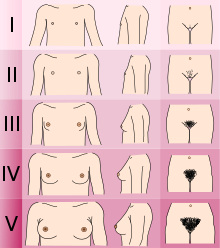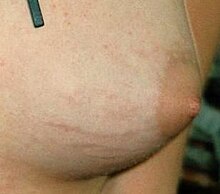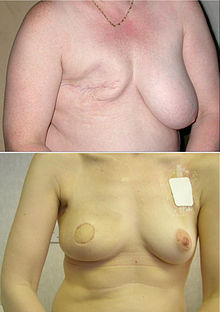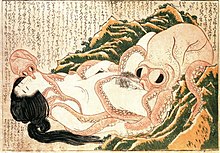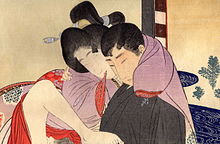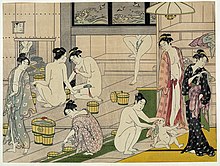| Breast | |
|---|---|

Morphology of human breasts with the areola, nipple, and inframammary fold
| |
| Details | |
| Artery | internal thoracic artery |
| Vein | internal thoracic vein |
| Identifiers | |
| Latin | mamma (mammalis "of the breast") |
| MeSH | D001940 |
| TA | A16.0.02.001 |
| FMA | 9601 |
The breast is one of two prominences located on the upper ventral region of the torso of primates. In females, it serves as the mammary gland, which produces and secretes milk to feed infants. Both females and males develop breasts from the same embryological tissues. At puberty, estrogens, in conjunction with growth hormone, cause breast development in female humans and to a much lesser extent in other primates. Breast development in other primate females generally only occurs with pregnancy.
Subcutaneous fat covers and envelops a network of ducts that converge on the nipple, and these tissues give the breast its size and shape. At the ends of the ducts are lobules, or clusters of alveoli, where milk is produced and stored in response to hormonal signals. During pregnancy, the breast responds to a complex interaction of hormones, including estrogens, progesterone, and prolactin, that mediate the completion of its development, namely lobuloalveolar maturation, in preparation of lactation and breastfeeding.
Along with their major function in providing nutrition for infants, female breasts have social and sexual characteristics. Breasts have been featured in notable ancient and modern sculpture, art, and photography. They can figure prominently in the perception of a woman's body and sexual attractiveness. A number of cultures associate breasts with sexuality and tend to regard bare breasts in public as immodest or indecent. Breasts, especially the nipples, are an erogenous zone.
Etymology and terminology
The English word breast derives from the Old English word brēost (breast, bosom) from Proto-Germanic breustam (breast), from the Proto-Indo-European base bhreus– (to swell, to sprout). The breast spelling conforms to the Scottish and North English dialectal pronunciations. The Merriam-Webster Dictionary states that "Middle English brest, [comes] from Old English brēost; akin to Old High German brust..., Old Irish brú [belly], [and] Russian bryukho"; the first known usage of the term was before the 12th century.A large number of colloquial terms for breasts are used in English, ranging from fairly polite terms to vulgar or slang. Some vulgar slang expressions may be considered to be derogatory or sexist to women.
Anatomy
The breast: cross-section scheme of the mammary gland.
In women, the breasts overlie the pectoralis major muscles and usually extend from the level of the second rib to the level of the sixth rib in the front of the human rib cage;
thus, the breasts cover much of the chest area and the chest walls. At
the front of the chest, the breast tissue can extend from the clavicle (collarbone) to the middle of the sternum (breastbone). At the sides of the chest, the breast tissue can extend into the axilla (armpit), and can reach as far to the back as the latissimus dorsi muscle, extending from the lower back to the humerus bone (the bone of the upper arm). As a mammary gland, the breast is composed of differing layers of tissue, predominantly two types: adipose tissue; and glandular tissue, which affects the lactation functions of the breasts.
Morphologically the breast is tear-shaped. The superficial tissue layer (superficial fascia) is separated from the skin by 0.5–2.5 cm of subcutaneous fat (adipose tissue). The suspensory Cooper's ligaments
are fibrous-tissue prolongations that radiate from the superficial
fascia to the skin envelope. The female adult breast contains 14–18
irregular lactiferous lobes that converge at the nipple. The 2.0–4.5 mm
milk ducts are immediately surrounded with dense connective tissue that
support the glands. Milk exits the breast through the nipple, which is
surrounded by a pigmented area of skin called the areola. The size of
the areola can vary widely among women. The areola contains modified sweat glands known as Montgomery's glands. These glands secrete oily fluid that lubricate and protect the nipple during breastfeeding. Volatile compounds in these secretions may also serve as an olfactory stimulus for the newborn's appetite.
The dimensions and weight of the breast vary widely among women. A
small-to-medium-sized breast weighs 500 grams (1.1 pounds) or less, and
a large breast can weigh approximately 750 to 1,000 grams (1.7 to 2.2
pounds) or more. The tissue composition ratios of the breast also vary
among women. Some women's breasts have varying proportions of glandular
tissue than of adipose or connective
tissues. The fat-to-connective-tissue ratio determines the density or
firmness of the breast. During a woman's life, her breasts change size,
shape, and weight due to hormonal changes during puberty, the menstrual cycle, pregnancy, breastfeeding, and menopause.
Glandular structure
The breast is an apocrine gland that produces the milk used to feed an infant. The nipple of the breast is surrounded by the areola
(nipple-areola complex). The areola has many sebaceous glands, and the
skin color varies from pink to dark brown. The basic units of the breast
are the terminal duct lobular units (TDLUs), which produce the fatty
breast milk. They give the breast its offspring-feeding functions as a
mammary gland. They are distributed throughout the body of the breast.
Approximately two-thirds of the lactiferous tissue is within 30 mm of
the base of the nipple. The terminal lactiferous ducts drain the milk
from TDLUs into 4–18 lactiferous ducts, which drain to the nipple. The
milk-glands-to-fat ratio is 2:1 in a lactating woman, and 1:1 in a
non-lactating woman. In addition to the milk glands, the breast is also
composed of connective tissues (collagen, elastin), white fat, and the suspensory Cooper's ligaments. Sensation in the breast is provided by the peripheral nervous system innervation by means of the front (anterior) and side (lateral) cutaneous branches of the fourth-, fifth-, and sixth intercostal nerves. The T-4 nerve (Thoracic spinal nerve 4), which innervates the dermatomic area, supplies sensation to the nipple-areola complex.
Lymphatic drainage
Approximately 75% of the lymph from the breast travels to the axillary lymph nodes on the same side of the body, whilst 25% of the lymph travels to the parasternal nodes (beside the sternum bone). A small amount of remaining lymph travels to the other breast and to the abdominal lymph nodes. The axillary lymph nodes
include the pectoral (chest), subscapular (under the scapula), and
humeral (humerus-bone area) lymph-node groups, which drain to the
central axillary lymph nodes and to the apical axillary lymph nodes. The lymphatic drainage of the breasts is especially relevant to oncology because breast cancer is common to the mammary gland, and cancer cells can metastasize (break away) from a tumour and be dispersed to other parts of the body by means of the lymphatic system.
Shape, texture, and support
The morphologic variations in the size, shape, volume, tissue
density, pectoral locale, and spacing of the breasts determine their
natural shape, appearance, and position on a woman's chest. Breast size
and other characteristics do not predict the fat-to-milk-gland ratio or
the potential for the woman to nurse an infant. The size and the shape
of the breasts are influenced by normal-life hormonal changes
(thelarche, menstruation, pregnancy, menopause) and medical conditions
(e.g. virginal breast hypertrophy).
The shape of the breasts is naturally determined by the support of the
suspensory Cooper's ligaments, the underlying muscle and bone structures
of the chest, and by the skin envelope. The suspensory ligaments
sustain the breast from the clavicle (collarbone) and the
clavico-pectoral fascia (collarbone and chest) by traversing and
encompassing the fat and milk-gland tissues. The breast is positioned,
affixed to, and supported upon the chest wall, while its shape is
established and maintained by the skin envelope. In most women, one breast is slightly larger than the other. More obvious and persistent asymmetry in breast size occurs in up to 25% of women.
While it has been a common belief that breastfeeding causes breasts to sag, researchers have found that a woman's breasts sag due to four key factors: cigarette smoking, number of pregnancies, gravity, and weight loss or gain.
The base of each breast is attached to the chest by the deep
fascia over the pectoralis major muscles. The space between the breast
and the pectoralis major muscle, called retromammary space, gives mobility to the breast.
The chest (thoracic cavity) progressively slopes outwards from the thoracic inlet (atop the breastbone)
and above to the lowest ribs that support the breasts. The inframammary
fold, where the lower portion of the breast meets the chest, is an
anatomic feature created by the adherence of the breast skin and the
underlying connective tissues of the chest; the IMF is the lower-most
extent of the anatomic breast. Normal breast tissue typically has a
texture that feels nodular or granular, to an extent that varies
considerably from woman to woman.
The study The Evolution of the Human Breast (2001)
proposed that the rounded shape of a woman's breast evolved to prevent
the sucking infant offspring from suffocating while feeding at the teat;
that is, because of the human infant's small jaw, which did not project
from the face to reach the nipple, he or she might block the nostrils against the mother's breast if it were of a flatter form (cf. common chimpanzee). Theoretically, as the human jaw receded into the face, the woman's body compensated with round breasts.
Development
The breasts are principally composed of adipose, glandular, and connective tissues. Because these tissues have hormone receptors,
their sizes and volumes fluctuate according to the hormonal changes
particular to thelarche (sprouting of breasts), menstruation (egg
production), pregnancy (reproduction), lactation (feeding of offspring),
and menopause (end of menstruation).
Puberty
Five-stage Tanner Scale
The morphological structure of the human breast is identical in males and females until puberty. For pubescent girls in thelarche (the breast-development stage), the female sex hormones (principally estrogens) in conjunction with growth hormone
promote the sprouting, growth, and development of the breasts. During
this time, the mammary glands grow in size and volume and begin resting
on the chest. These development stages of secondary sex characteristics (breasts, pubic hair, etc.) are illustrated in the five-stage Tanner Scale.
During thelarche
the developing breasts are sometimes of unequal size, and usually the
left breast is slightly larger. This condition of asymmetry is
transitory and statistically normal in female physical and sexual
development. Medical conditions can cause overdevelopment (e.g., virginal breast hypertrophy, macromastia) or underdevelopment (e.g., tuberous breast deformity, micromastia) in girls and women.
Approximately two years after the onset of puberty (a girl's first menstrual cycle),
estrogen and growth hormone stimulate the development and growth of the
glandular fat and suspensory tissues that compose the breast. This
continues for approximately four years until the final shape of the
breast (size, volume, density) is established at about the age of 21. Mammoplasia (breast enlargement) in girls begins at puberty, unlike all other primates in which breasts enlarge only during lactation.
Breast with visible stretch marks
Changes during the menstrual cycle
During the menstrual cycle, the breasts are enlarged by premenstrual water retention and temporary growth.
Pregnancy and breastfeeding
The breasts reach full maturity only when a woman's first pregnancy occurs.
Changes to the breasts are among the very first signs of pregnancy.
The breasts become larger, the nipple-areola complex becomes larger and
darker, the Montgomery's glands
enlarge, and veins sometimes become more visible. Breast tenderness
during pregnancy is common, especially during the first trimester. By
mid-pregnancy, the breast is physiologically capable of lactation and
some women can express colostrum, a form of breast milk.
Pregnancy causes elevated levels of the hormone prolactin, which has a key role in the production of milk. However, milk production is blocked by the hormones progesterone and estrogen until after delivery, when progesterone and estrogen levels plummet.
Menopause
At menopause, breast atrophy occurs. The breasts can decrease in size
when the levels of circulating estrogen decline. The adipose tissue and
milk glands also begin to wither. The breasts can also become enlarged
from adverse side effects of combined oral contraceptive pills. The size of the breasts can also increase and decrease in response to weight fluctuations. Physical changes to the breasts are often recorded in the stretch marks
of the skin envelope; they can serve as historical indicators of the
increments and the decrements of the size and volume of a woman's
breasts throughout the course of her life.
Breastfeeding
The primary function of the breasts, as mammary glands, is the nourishing of an infant with breast milk.
Milk is produced in milk-secreting cells in the alveoli. When the
breasts are stimulated by the suckling of her baby, the mother's brain
secretes oxytocin.
High levels of oxytocin trigger the contraction of muscle cells
surrounding the alveoli, causing milk to flow along the ducts that
connect the alveoli to the nipple.
Full-term newborns have an instinct and a need to suck on a
nipple, and breastfed babies nurse for both nutrition and for comfort.
Breast milk provides all necessary nutrients for the first six months
of life, and then remains an important source of nutrition, alongside
solid foods, until at least one or two years of age.
Clinical significance
The breast is susceptible to numerous benign and malignant conditions. The most frequent benign conditions are puerperal mastitis, fibrocystic breast changes and mastalgia.
Lactation unrelated to pregnancy is known as galactorrhea. It can be caused by certain drugs (such as antipsychotic medications), extreme physical stress, or endocrine
disorders. Lactation in newborns is caused by hormones from the mother
that crossed into the baby's bloodstream during pregnancy.
Breast cancer
Breast cancer is the most common cause of cancer death among women
and it is one of the leading causes of death among women. Factors that
appear to be implicated in decreasing the risk of breast cancer are
regular breast examinations by health care professionals, regular mammograms, self-examination of breasts, healthy diet, and exercise to decrease excess body fat, and breastfeeding.
Male breasts
Both females and males develop breasts from the same embryological tissues. Normally, males produce lower levels of estrogens and higher levels of androgens, namely testosterone, which suppress the effects of estrogens in developing excessive breast tissue.
In boys and men, abnormal breast development is manifested as gynecomastia, the consequence of a biochemical imbalance between the normal levels of estrogen and testosterone in the male body. Around 70% of boys temporarily develop breast tissue during adolescence.
The condition usually resolves by itself within two years. When male lactation occurs, it is considered a symptom of a disorder of the pituitary gland.
Plastic surgery
Conventional mastectomy (top); skin sparing mastectomy and latissimus dorsi myocutaneous flap reconstruction, prior to nipple reconstruction and tattooing (bottom).
Plastic surgery can be performed to augment or reduce the size of breasts, or reconstruct the breast in cases of deformative disease, such as breast cancer. Breast augmentation and breast lift (mastopexy) procedures are done only for cosmetic reasons, whereas breast reduction is sometimes medically indicated.
In cases where a woman's breasts are severely asymmetrical, surgery can
be performed to either enlarge the smaller breast, reduce the size of
the larger breast, or both.
Breast augmentation surgery generally does not interfere with future ability to breastfeed.
Breast reduction surgery more frequently leads to decreased sensation
in the nipple-areola complex, and to low milk supply in women who choose
to breastfeed. Implants can interfere with mammography (breast x-rays images).
Society and culture
General
In Christian iconography,
some works of art depict women with their breasts in their hands or on a
platter, signifying that they died as a martyr by having their breasts
severed; one example of this is Saint Agatha of Sicily.
Femen member participating in a protest
Femen is a feminist activist group which uses topless protests as part of their campaigns against sex
tourism religious institutions, sexism, homophobia and to "defend [women's] right to abortion". Femen activists have been regularly detained by police in response to their protests.
There is a long history of female breasts being used by comedians as a subject for comedy fodder (e.g., British comic Benny Hill's burlesque/slapstick routines).
Art history
In European pre-historic societies, sculptures of female figures with
pronounced or highly exaggerated breasts were common. A typical example
is the so-called Venus of Willendorf, one of many Paleolithic Venus figurines
with ample hips and bosom. Artifacts such as bowls, rock carvings and
sacred statues with breasts have been recorded from 15,000 BC up to late
antiquity all across Europe, North Africa and the Middle East.
Many female deities representing love and fertility were
associated with breasts and breast milk. Figures of the Phoenician
goddess Astarte were represented as pillars studded with breasts. Isis, an Egyptian goddess who represented, among many other things, ideal motherhood, was often portrayed as suckling pharaohs,
thereby confirming their divine status as rulers. Even certain male
deities representing regeneration and fertility were occasionally
depicted with breast-like appendices, such as the river god Hapy who was considered to be responsible for the annual overflowing of the Nile.
Female breasts were also prominent in the Minoan civilization in the form of the famous Snake Goddess statuettes. In Ancient Greece there were several cults worshipping the "Kourotrophos", the suckling mother, represented by goddesses such as Gaia, Hera and Artemis.
The worship of deities symbolized by the female breast in Greece became
less common during the first millennium. The popular adoration of
female goddesses decreased significantly during the rise of the Greek
city states, a legacy which was passed on to the later Roman Empire.
During the middle of the first millennium BC, Greek culture
experienced a gradual change in the perception of female breasts. Women
in art were covered in clothing from the neck down, including female
goddesses like Athena, the patron of Athens who represented heroic endeavor. There were exceptions: Aphrodite,
the goddess of love, was more frequently portrayed fully nude, though
in postures that were intended to portray shyness or modesty, a
portrayal that has been compared to modern pin ups by historian Marilyn Yalom.
Although nude men were depicted standing upright, most depictions of
female nudity in Greek art occurred "usually with drapery near at hand
and with a forward-bending, self-protecting posture". A popular legend at the time was of the Amazons,
a tribe of fierce female warriors who socialized with men only for
procreation and even removed one breast to become better warriors (the
idea being that the right breast would interfere with the operation of a
bow and arrow). The legend was a popular motif in art during Greek and
Roman antiquity and served as an antithetical cautionary tale.
- A Cretan snake goddess from the Minoan civilization, c. 1600 BC
- 1825 oil painting entitled Tetuppa, a Native Female of the Sandwich Islands, by Robert Dampier
Body image
Many women regard their breasts as important to their sexual attractiveness, as a sign of femininity that is important to their sense of self.
Clothing
As is customary in her culture, a bare-breasted Himba woman of northern Namibia wears a traditional headdress and skirt
Because breasts are mostly fatty tissue, their shape can -within limits- be molded by clothing, such as foundation garments. Bras are commonly worn by about 90% of Western women, and are often worn for support. The social norm in most Western cultures
is to cover breasts in public, though the extent of coverage varies
depending on the social context. Some religions ascribe a special status
to the female breast, either in formal teachings or through symbolism. Islam forbids women from exposing their breasts in public.
Many cultures, including Western cultures in North America, associate breasts with sexuality and tend to regard bare breasts as immodest or indecent. In some cultures, like the Himba in northern Namibia,
bare-breasted women are normal. In some African cultures, for example,
the thigh is regarded as highly sexualised and never exposed in public,
but breast exposure is not taboo. In a few Western countries and regions female toplessness at a beach is acceptable, although it may not be acceptable in the town center.
Social attitudes and laws regarding breastfeeding in public
vary widely. In many countries, breastfeeding in public is common,
legally protected, and generally not regarded as an issue. However, even
though the practice may be legal or socially accepted, some mothers may
nevertheless be reluctant to expose a breast in public to breastfeed due to actual or potential objections by other people, negative comments, or harassment. It is estimated that around 63% of mothers across the world have publicly breast-fed. Bare-breasted women are legal and culturally acceptable at public beaches in Australia and much of Europe. Filmmaker Lina Esco made a film entitled Free the Nipple,
which is about "...laws against female toplessness or restrictions on
images of female, but not male, nipples", which Esco states is an
example of sexism in society.
Sexual characteristic
In some cultures, breasts play a role in human sexual activity. In Western culture, breasts have a "...hallowed sexual status, arguably more fetishized than either sex’s genitalia". Breasts and especially the nipples are among the various human erogenous zones. They are sensitive to the touch as they have many nerve endings; and it is common to press or massage them with hands or orally before or during sexual activity. During sexual arousal, breast size increases, venous
patterns across the breasts become more visible, and nipples harden.
Compared to other primates, human breasts are proportionately large
throughout adult females' lives. Some writers have suggested that they
may have evolved as a visual signal of sexual maturity and fertility.
Many people regard bare female breasts to be aesthetically pleasing or erotic, and they can elicit heightened sexual desires in men in many cultures. In the ancient Indian work the Kama Sutra, light scratching of the breasts with nails and biting with teeth are considered erotic. Some people show a sexual interest in female breasts distinct from that of the person, which may be regarded as a breast fetish. A number of Western fashions include clothing which accentuate the breasts, such as the use of push-up bras and decollete (plunging neckline) gowns and blouses which show cleavage.
While U.S. culture prefers breasts that are youthful and upright, some
cultures venerate women with drooping breasts, indicating mothering and
the wisdom of experience.
Research conducted at the Victoria University of Wellington showed that breasts are often the first thing men look at, and for a longer time than other body parts. The writers of the study had initially speculated that the reason for this is due to endocrinology with larger breasts indicating higher levels of estrogen and a sign of greater fertility,
but the researchers said that "Men may be looking more often at the
breasts because they are simply aesthetically pleasing, regardless of
the size."
Some women report achieving an orgasm from nipple stimulation, but this is rare.
Research suggests that the orgasms are genital orgasms, and may also be
directly linked to "the genital area of the brain". In these cases, it
seems that sensation from the nipples travels to the same part of the
brain as sensations from the vagina, clitoris and cervix. Nipple
stimulation may trigger uterine contractions, which then produce a
sensation in the genital area of the brain.
Anthropomorphic geography
There are many mountains named after the breast because they resemble
it in appearance and so are objects of religious and ancestral
veneration as a fertility symbol and of well-being. In Asia, there was
"Breast Mountain", which had a cave where the Buddhist monk Bodhidharma (Da Mo) spent much time in meditation. Other such breast mountains are Mount Elgon on the Uganda-Kenya border, Beinn Chìochan and the Maiden Paps in Scotland, the "Bundok ng Susong Dalaga" (Maiden's breast mountains) in Talim Island, Philippines, the twin hills known as the Paps of Anu (Dá Chích Anann or "the breasts of Anu"), near Killarney in Ireland, the 2,086 m high Tetica de Bacares or "La Tetica" in the Sierra de Los Filabres, Spain, and Khao Nom Sao in Thailand, Cerro Las Tetas in Puerto Rico and the Breasts of Aphrodite in Mykonos, among many others. In the United States, the Teton Range is named after the French word for "breast".

